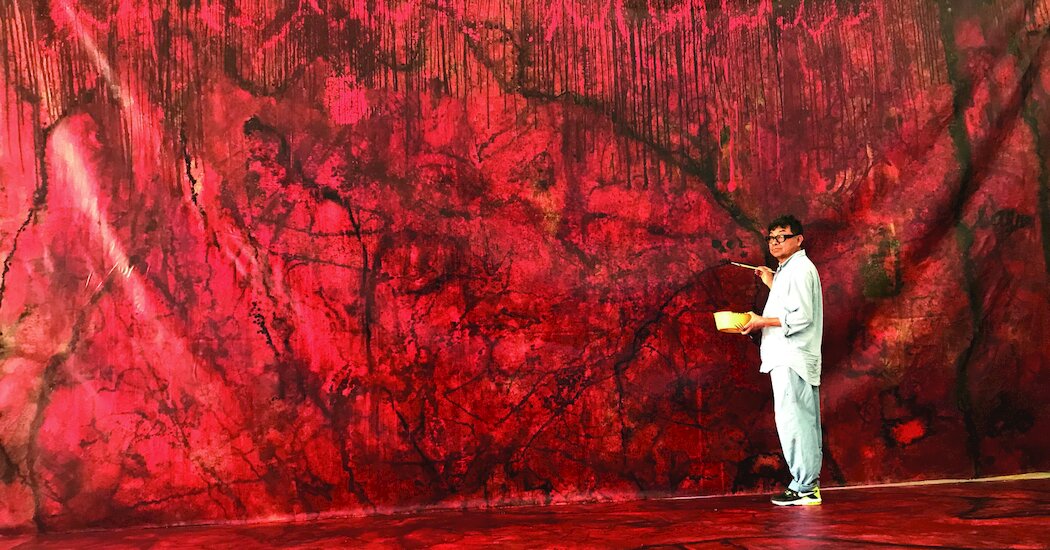This text is a part of our Tremendous Arts & Displays particular part on how museums, galleries and public sale homes are embracing new artists, new ideas and new traditions.
SAN DIEGO — Most individuals in all probability know piñatas as ephemeral paper-and-cardboard sculptures, made to be smashed by kids to get the treats hidden inside. However on the Mingei International Museum in San Diego, they’re complicated, lovely artistic endeavors and storytelling.
“Piñatas: The High Art of Celebration,” which runs from Oct. 29 to April 30, is only one of a number of exhibitions opening this fall in Southern California that remember the skills and works of Latino artists.
Greater than 80 piñatas are featured, together with a 12-foot-long string of rosary beads, a life-size lowrider and swarms of tiny hummingbirds and Monarch butterflies.
Though the historical past of the piñata isn’t properly documented, it’s believed to have originated in historical China, which had a practice of shattering a ceramic ox stuffed with seeds throughout a springtime ceremony, mentioned Emily Zaiden, the visitor curator of the Mingei exhibition.
Piñatas started showing in northern Italy and Spain within the sixteenth century, Ms. Zaiden mentioned, and had been taken to Mexico by missionaries, who used them at Christmas celebrations to attract Indigenous peoples to the church. The present on the Mingei, she mentioned, “pushes the concept of what a piñata could be — metaphors for Latinx id and for the sorts of hierarchies and oppression that exist in society in the present day, in addition to political symbols.”
Diana Benavidez, a binational artist whose work is included within the exhibition (she can also be the training specialist on the museum), first discovered how piñatas had been made as a baby in Tijuana, serving to out at a buddy’s sweet store. She was stunned at how a lot effort went into creating objects meant to be destroyed. “From that time on, I began to see piñatas as undervalued sculptures,” she mentioned.
Isaías Rodríguez, an artist who teaches the craft of piñata-making by his enterprise, My Little Piñatas, created an set up for the Mingei that options greater than 200 hummingbirds and 300 Monarch butterflies, every a piñata no greater than the palm of his hand. For Mr. Rodríguez, making piñatas is a celebration of his personal historical past, in addition to Chicano artwork and tradition. “I determine as a third-generation Chicano from L.A.,” he mentioned. “Rising up in a poor, working-class household in Boyle Heights, with 12 youngsters, we had our fair proportion of piñata occasions.”
Roberto Benavidez (who isn’t associated to Diana), a sculptor initially from South Texas and now dwelling in Los Angeles, contributed a number of piñatas, a few of which take the type of fantastical creatures, like “Javelina Woman,” which has a shimmering, feathery turquoise-and-silver physique.
Mr. Benavidez has mentioned he attracts inspiration from Hieronymous Bosch’s “The Backyard of Earthly Delights.”
Opening in November on the San Diego Museum of Art is “Sergio Hernández: Embers of Oaxaca,” the primary solo museum exhibition in america for this Indigenous Mexican artist. Mr. Hernandez is a part of an extended historical past of influential painters from the state of Oaxaca.
Of the greater than 30 works within the present, about half are monumental in scale; a few of them are 10 toes extensive, mentioned Michael Brown, the exhibition’s curator.
“Lots of the works heart on the pure world and our place inside it, in addition to the historical past of the Indigenous peoples in and round Hernández’ native Oaxaca,” he mentioned. Mr. Hernández typically incorporates cochineal, a beetle-based pink pigment developed by Indigenous artists earlier than the Spanish conquest, into his work. He additionally makes use of Oaxacan sand and gold leaf, the latter a nod to the worth of gold to the Aztecs, who managed the world within the 1500s. The exhibition consists of work and prints as properly.
The items on this exhibition — which embrace seven new work — are sometimes fantastical and dreamlike. They embrace depictions of ocean scenes, jungles, human and animal figures, skulls, masks, nymphs and bugs, and are sometimes monochromatic.
In an electronic mail, Mr. Hernandez wrote that his work was a mirrored image of his private historical past, “stuffed with myths, sorcerers and healers, of nahuales or spirits, open fires and herbs.” And though his work don’t immediately deal with local weather change, Mr. Hernández mentioned that his travels around the globe had “made me notice there’s much less and fewer of the planet I’m attempting to color.”
Different noteworthy exhibitions embrace a retrospective of more than 30 years of work by the brothers Einar and Jamex de la Torre at the Cheech Marin Center for Chicano Art & Culture of the Riverside Art Museum. Initially from Guadalajara, Mexico, the brothers now stay in San Diego and Baja California, Mexico.
This exhibition, “Collidoscope: de la Torre Brothers Retro-Perspective,” consists of greater than 70 mixed-media works. The duo are recognized for his or her blown-glass sculptures, and the items on this exhibition have a kaleidoscopic, surreal high quality — a collision of colours, photos, themes and supplies. Lots of the works are additionally darkly humorous. “La Belle Epoch” is especially spectacular: a flamboyant tackle the Sun Stone, which is likely one of the most well-known artifacts from the Aztecs.
The de la Torre model is a 10-foot-high Ferris wheel, its circumference punctuated by human hearts in rotation across the Aztec solar god, Huitzilopochtli, who holds a knife in a single hand and a liquor bottle within the different. That is certainly one of two inaugural exhibitions on the Cheech, one of many nation’s first everlasting areas devoted to Chicano artwork and tradition.
“Arte Para La Gente: The Collected Works of Margaret Garcia” runs by June 11 at LA Plaza de Cultural y Artes in Los Angeles and consists of greater than 75 works by this native Chicana artist and instructor. Ms. Garcia is thought for her portraits of individuals within the Chicano group, together with store house owners, artists, meals and fruit distributors and the homeless. “The folks she paints, within the Black and brown communities, don’t usually discover themselves represented in artwork,” mentioned Karen Crews Hendon, senior curator at LA Plaza. “She has a really expressionist manner of portray, with vivid, daring colours.”
In early October, the Chicano Park Museum and Cultural Center opened in Logan Heights, San Diego’s oldest Mexican-American neighborhood. It’s devoted to celebrating and preserving the historical past of the neighborhood and Chicano Park, which exists due to the activism of native residents in 1970.
Two years after the land beneath the Coronado Bay Bridge was formally christened Chicano Park, native artists started portray colorful murals on the bridge pylons. At this time, there are more than 80.
The museum’s first exhibition, “PILLARS: Stories of Resilience and Self-Determination,” consists of 12 six-foot-high indoor pillars, every of which has been used as a canvas by teams affiliated with the group to color their particular person tales.

